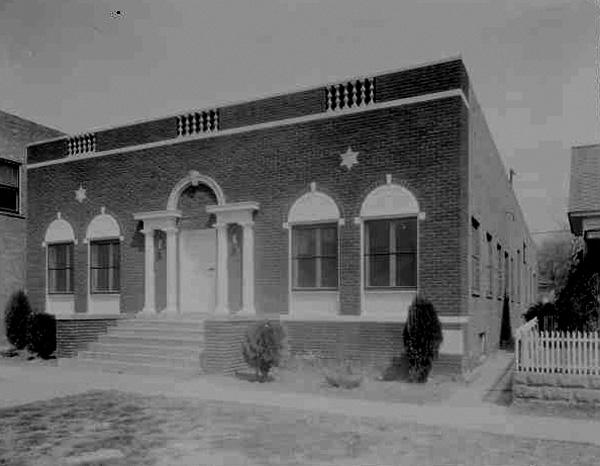Tulsa History: April 2014 Archives
Emerson Elementary School, north of downtown Tulsa at 909 N. Boston Ave, will celebrate its centennial this Friday night, May 2, 2014, from 6 to 8 pm. Dinner will be provided by Elote and music by Muskogee's Wild Card Band. There will be a silent auction to benefit the school's Science, Technology, Engineering, and Math (STEM) initiative. Tickets are $10 for adults, $5 for children 11-17. Visit Emerson's "purchases and donations" page to buy tickets and centennial T-shirts.
In researching a story about the neighborhood south of Emerson, I've enjoyed talking to a number of alumni who attended the school in the '40s and '50s and getting to know the school's long and fascinating history.
Emerson School dates its birth from its authorization in Tulsa's 1913 school bond issue. A April 14, 1915, story, headlined "BUILD NEW SCHOOL ON THE NORTH SIDE: Buy Block In Kirkpatrick Heights for a Unit Building," reported:
Amicably settling the slight dissention [sic] which recently arose between the North Side Improvement association and the city school board, it was decided at the meeting of the school board last night to purchase a block of ground in the Kirkpatrick Heights addition for a new school site and build an entirely new unit school at that place. In view of the unsafe condition of the Sequoyah school, for a large number of children, it was decided to diminish the attendance there as well as repair the building and render it safe as far as possible.It is thought probable that the Osage school, which is a grade school, would never likely grow very much, shall be made the location for the manual training and domestic science departments for the more advanced students of the north side. This will prevent their having to go as far south as the central high school or as far east as Washington school to take that course of study. Members of the North Side Improvement association present expressed themselves before the board and privately as being entirely satisfied with the arrangement.
(On the same page, a box score and news story announced that the Tulsa World-Democrat newsboys baseball team, the Newsies, had defeated Bellview (Lincoln) elementary school 7-6 and Horace Mann elementary 10-2 in a Sunday afternoon double header. For more information about the concerns of this period for school building soundness and safety, see "'JITNEY' SCHOOLS ARE 'ALL BLOWED UP'" in the September 8, 1915, Tulsa World.)
A month later, on May 19, 1915, the school board approved, with one member dissenting, the purchase of a block in Kirkpatrick Heights and rejecting the Mary Davis site. (That may be a reference to the Davis-Wilson Heights Addition, on the east side of Cincinnati at the top of Sunset Hill. The same page discusses work on the Detention Home and has an ad from the Tulsa Theatre Managers Association about a wildcat strike by union musicians, stagehands and operators.)
A Sunday, September 19, 1915, news story about the reopening of the school year the following day announces that enrollment for the new school in Kirkpatrick Heights would be held at Osage (Fairview west of Denver) and Sequoyah Schools (Boston and Easton) "A separation of the district will be made, as soon as the building is completed." A January 4, 1916, story reports that Emerson school "will be occupied tomorrow," with only one further school from the last bond issue to be completed (Riverview).
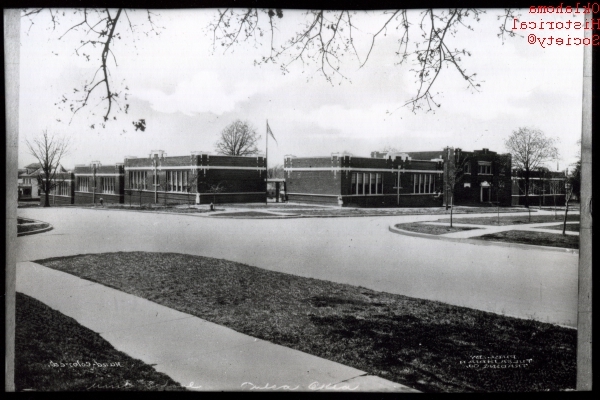
NOTE: It appears that the Oklahoma Historical Society had the photo backwards. Based on aerial photos, the auditorium was on King Street, second building east of Boston. When reversed, the photo matches the slope of the land.
Emerson has had two incarnations. Its first was as a campus on the east side of Boston between King and Latimer Streets, occupying about half a block and built according to the "unit plan" devised by school board member H. O. McClure, namesake of a Tulsa park and school. Each unit consisted of two classrooms with its own restrooms and cloakrooms. As enrollment grew, additional units would be built, gradually enclosing an inner courtyard. One two-story building housed the auditorium and school offices. The plan was innovative and received national attention. While many unit plan schools, including Emerson, have been demolished, a few remain, and most have been put to other purposes: Lee School at 21st and Cincinnati, Irving School at 1st and Nogales, Pershing School in Owen Park neighborhood, and Lincoln School at 15th and Peoria. In some cases, like Lincoln and Irving, units were constructed around multistory school buildings.
The courtyard wasn't big enough for baseball; little league games were played several blocks north at Cheyenne Playground.

Prior to school desegregation, Emerson was a school for whites only. After Brown v. Board of Education, starting in 1955, a few African-American children enrolled in the school. Bill Leighty, who was an Emerson student at the time, remembers that the change was uneventful and the new students were welcomed. Over the next 20 years, changing school boundaries and changing residential patterns (influenced in part by the urban renewal demolition of Greenwood and the displacement of its residents) resulted in Emerson becoming a majority African-American school; 87.4% in the 1975-1976 school year.
The second, modern incarnation of Emerson began in 1975, as part of a plan to desegregate schools without forced busing. Tulsa proposed, and the Federal judge accepted, a plan to build a new Emerson School as a magnet, to complement new magnet schools at Carver Middle School and Washington High School. Charles Johnson Elementary, located in the old Washington building in the Greenwood district, and which had been one of the segregated "separate" schools for African-Americans, would be closed and merged into Emerson. Longfellow, at 6th and Peoria, had been closed and merged into Johnson for the 1972-1973, to try to create a balanced student body.
Building this superschool involved the creation of a superblock, demolishing the original buildings and the houses on the rest of its block, the block to the south, and two blocks to the west. Forty-six single-family homes, three duplexes, seven apartment buildings, and a small retail building at 14 E. Latimer (home in in 1957 to Tulsa Nozzle and Valve, in 1967 to the Edge of Night beer joint) were removed. King Street was closed between Cincinnati Ave (now MLKJr Blvd) and Main, and Boston Ave was closed between Jasper Street and Latimer Street.
The new Emerson, which opened its doors in 1976, had a brand new, modern building, innovative curriculum offerings, and highly-credentialed teachers. From a 1977 report to the U. S. Commission on Civil Rights about the desegregation of Tulsa schools:
On April 24, 1975, District Judge Frederick Daugherty issued an order with regard to Emerson Elementary School. The order approved the school districts request to build a new elementary school based on an expansion of the existing Emerson campus. Student assignment changes were made by consolidating the enrollments of Emerson and Johnson Elementary Schools. The court stipulated that the new Emerson must maintain a black enrollment of not more than 50 percent. The school district, expanding on its previous successes at Burroughs Little School, Carver Middle School, and Washington High School, sought voluntary white student enrollment. The court had made it quite clear that, if the voluntary approach did not work, the district would have to take other action to maintain the prescribed racial enrollment in the new school.The new Emerson Elementary, which opened in September 1976, formed the final link in a complete K-12 alternative school program where students can experience individualized, continuous-progress learning in a racially desegregated environment. The total enrollment of 700, with a 50-50 black-white ratio, consists of approximately 500 neighborhood children and an additional 200 white student volunteers. Children in grades K-3 are located in a special area with ready access to other activity areas. The curriculum emphasizes communication skills and mathematics taught by a team of teachers. Enrichment experiences include music, drama, and creative arts at this level.
Children in grades three through six have three time blocks of 110 minutes each allotted to communication skills, math-science, physical education, and humanities. Additional instruction in music is available on the violin, guitar, and piano beginning at the third-grade level.Although the main emphasis is on basic skills geared for individualized instruction, the curriculum stresses a humanities program. Children at Emerson have access to a piano laboratory, a potter's wheel, instruction in dance and drama, and a miniature television studio where they can produce their own shows. The curriculum features a creative learning center where children may engage in enrichment experiences in the arts, crafts, plant growing, and creative writing. This component of the curriculum is closely articulated with the exploratory curriculum at Carver Middle School so that Emerson students can continue their entire public school education through similar programs at Carver Middle School and Washington High School.
Today, Emerson is the neighborhood school for a three-square mile area that includes all of downtown within the Inner Dispersal Loop plus an area bounded by the L. L. Tisdale Expressway, Peoria Avenue, Pine Street and 11th Street. It feeds into Central Junior and Senior high schools. At the start of this academic year, Emerson had 311 students and 23 teachers. 95% of students qualify for free or reduced lunch. 70% of the students are African-American. Student attendance rate last year was 94%.
From p. 3 of the August 23, 1922, edition of the Tulsa Daily World:
A building permit was issued Tuesday to the Jewish Institute, which is to be located at 629 N. Main street. The plans call for a one-story building and basement, with a large assembly hall. The cost is estimated at $20,000.
From p. 3 of the August 27, 1922, edition of the Tulsa Daily World:
The cornerstone of the Jewish Institute of Tulsa will be laid on Tuesday evening, August 28, at 8 o'clock at 627 North Main. This institution, when completed, will be equipped with a spacious hall for dances and mass meetings, club rooms, reading rooms, library, chess room and various facilities for games, a kitchen for the catering for Jewish social affairs, and other attractions that will make the Jewish Institute a center of Jewish social life.
Here's a description of the institute's location and purpose from the article about Tulsa by the Institute of Southern Jewish Life:
Members of B'nai Emunah built a Jewish Institute, designed to be a community center, in 1922. Reflecting the scattered nature of the Orthodox synagogue's membership, the Jewish Institute was 1.5 miles away from B'nai Emunah. Nevertheless, the Orthodox synagogue's Talmud Torah school started meeting at the Institute, a vast improvement over the shul's basement, where they had been meeting. The B'nai Emunah sisterhood, which had been founded in 1921, held their meetings and functions at the Institute. The heyday of the Jewish Institute was short-lived, as financial troubles forced it to close in 1930. The building was still used by Jewish groups occasionally. Later in the 1930s, member of B'nai Emunah who lived on the northside met there for high holiday services since they lived too far from the synagogue to walk there. Abe Borofsky and Harold Smith were the lay leaders for the northside group.
I believe this is a photo of the Jewish Institute. The synagogues in Tulsa at the time were B'nai Emunah, a two-story building at 10th and Cheyenne, and Temple Israel, at 14th and Cheyenne. Both two-story buildings were topped by domes. This building better fits the newspaper's description of the Jewish Institute.
The Beryl Ford Collection/Rotary Club of Tulsa, Tulsa City-County Library and Tulsa Historical Society.
The Tulsa Daily World and the Tulsa Democrat both ran front page stories about Congress authorizing President Wilson to use the Armed Forces to intervene in Mexico.
The World's front page was almost entirely devoted to the impending Mexico invasion. Above the masthead, a red banner headline read "LAND MARINES 48 HOURS." The lead story announced "WILL SEIZE CUSTOM HOUSES AT TAMPICO AND VERA CRUZ WED." The only interruption was a "WARNING!" in the bottom center of the front page that the rival Democrat was producing a cheap imitation of the World's pink-paper special 6 p.m. sports edition with all the baseball scores.
The Whirled had the local angle, with a story about men across the state wiring and telephoning the Oklahoma National Guard's adjutant general to volunteer to fight in Mexico, and one special volunteer who offered to organize a special unit for any expedition:
Tulsa came to the front in the Mexican crisis last night when "Geenral" [sic] Tate Brady wired Senator [Thomas] Gore, asking for authority to raise a regiment of Indian cavalry volunteers to serve should war break out with Mexico. His telegram follows:"Senator Thomas P. Gore, Washington:
"The first man to lay down his life on Cuban soil for flag and country was Milo Hendrix, an Indian boy. In the great war between the states, the Indian people sent their full quota to both northern and southern armies. No soldiers were braver. They are specially qualified for duty in the mountains of Mexico. Proud of being a Cherokee citizen, I ask the president through you, if volunteers are called for, for the privilege of organizing a regiment of Indian cavalry for duty at the front.
(Signed) "TATE BRADY"
(The Democrat had Brady's letter on p. 10, the back page of this addition.)
Page 2 of the World announced movies every evening in the 1,200 capacity "airdome" at the Sand Springs Park. On page 4, we learn that the Tulsa baseball club in the Western Association is looking for a new name and will pay $10 in "real money" to the person who makes the winning suggestion. "'Oilers' is too common, as several teams in past years have had that moniker." Page 4 also has another tribute to Tate Brady, this time for his business acumen in moving his dry goods store from the a leased space on the south side to his Brady Hotel just north of the Frisco tracks. "Last year he retailed nearly ninety-one thousand dollars for cash and this year so far has been 44 per cent over last."
On the same page, The New Fashion Store at 112 E. 2nd Street cashes in on war fever with a quarter-page ad headlined:
WAR DECLARED
ON RETAIL PRICES IN TULSA
(They bought a full-page ad in the Democrat, p. 8, with the same headline.)
According to a Santa Fe ad on p. 7, you can take Train 202 out of Tulsa at 8 a.m., arrive in Kansas City at 5:15 p.m., take in dinner and a show, then catch the Oil Flyer at 2:30 a.m. (but sleepers are available at 11:30 p.m.), arriving back in Tulsa at 11:30 a.m. A caricature of the dapper "University Four" announces their upcoming show, "A Bit of Harmony" at the Lyric Theater.

The Democrat devoted only three of its seven front-page columns to the Mexico story. The big local story was preparations to send a delegation of Tulsans to the United Confederate Veterans convention in Jacksonville, Fla., to try to land the 1915 convention for Tulsa. A delegation of 200 men would take a special train to Jacksonville, over the southern route through Dallas, Houston, New Orleans, and Montgomery. In the two weeks before the UCV convention, 5,000 booklets about Tulsa, featuring a photo of the new convention hall, would be distributed in "the larger cities of the south."
A big chunk of the Democrat's front page is devoted to a sort of Socratic dialogue (headlined "Cloistered Conversations") between a Mr. Hymn and a Mr. Rockefeller concerning the latter's monopolistic oil pricing practices and the possibility of a shutdown of Oklahoma drilling in response to a decline in the price of oil. Page 2 has more on that topic, and a story about Oklahoma's desire to purchase unplatted islands and lands in the bed of the Arkansas River from the Department of the Interior. The question hinges in part on the navigability of the river. Another lengthy feature about Standard Oil's methods is on p. 4.
Page 3 of the Democrat has a big display ad decrying the folly of paying $30 a month or more in rent when you could instead by a new home in Crosbie Heights Addition, served by two streetcar lines, a mere 10 blocks from "down town," where "the scenery is splendid, the air is pure and free from the dirt and grime of the congested district of down town. In such location the children and wife will find health and happiness during the hot summer months. The altitude is such that you will find it coll during the hot nights of the coming summer."
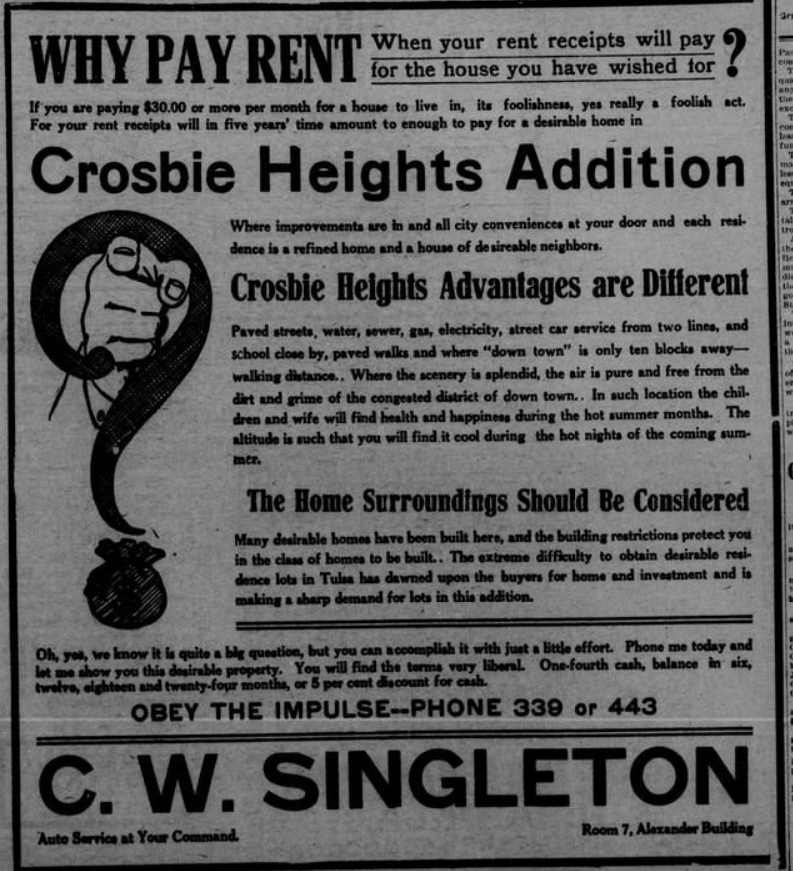
Speaking of streetcars, the same page announces that the Tulsa Street Railway will install a new switch on North Cheyenne Avenue, enabling more cars and more frequent service -- every seven minutes -- and the possibility of an extension of the North Main Street line. Meanwhile, the new line to the Bellview addition (3rd to Madison to Fostoria to Quincy, ending just south of 15th Street) would run on a 12-minute headway with the Owen Park line. The headways had been 18 minutes before recent improvements.
Also reported on page 3 of the Democrat, the Lutherans, led by the Rev. C. W. Sifferd, broke ground on April 21, 1914, for a new building on the southeast corner of 5th and Elwood, designed by George Winkler. The church had a membership of 140, but were building the new church to hold 750, with a full basement for Sunday school classrooms. (The building stood until demolished to make way for the Tulsa County Courthouse. First Lutheran Church relocated to 13th and Utica.)
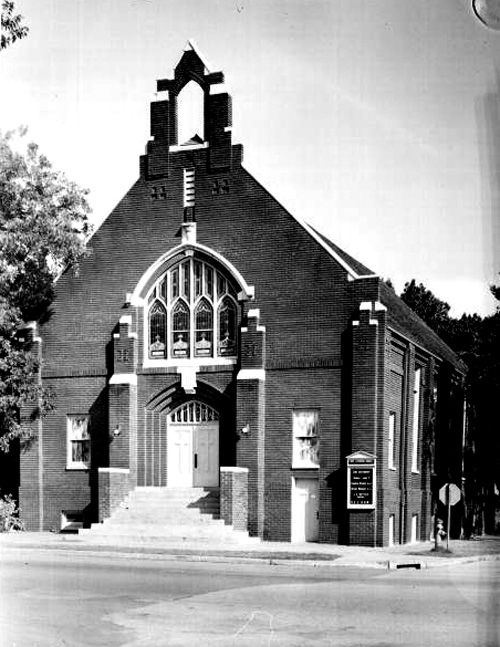
Beryl Ford Collection/Rotary Club of Tulsa, Accession A2289
As yet undeveloped, land near Boston Ave. and Haskell St. was the temporary home of lions, tigers, apes, and monkeys -- the Con T. Kennedy Shows and Hackman Animal Circus had come to town. (These days, the land is again re-undeveloped and could once again play host to a circus tent and midway.)
Page 6 of the Democrat reported the Western Association's 140 game schedule. Tulsa would open at home on May 1, starting a three-game series with the recently reinstated Muskogee club. Elsewhere on the page, the Tulsa school board was mulling plans to condemn a block of land to expand Riverview School. The board was ready to advertise plans to construct the new $300,000 High School, so that construction could start as soon as the state Attorney General approved the $500,000 bond issue. It hadn't been decided whether to build on the same block as the current school or a different one.
The 1914 City of Tulsa election, to be held the following day, would be a snoozer and warranted a mention only on the bottom right corner of page 7. The Democratic slate of city commission candidates were all unopposed, but the election had to be held in order to comply with the city charter.
A legal notice on p. 9 announced the sealed-bid auction of the Kaffir Corn Palace, on the grounds of the County Farm, on N. Lewis between Archer and the Frisco tracks. The building, celebrating what we call sorghum, was the centerpiece of the 1913 International Dry Farming Congress.
And finally, the classified ads on the back page of the World include a black manorca cockerel for sale at 901 No. Cheyenne (eggs, too), rooms for rent (inquire at the Coney Island Café), and this touching personal:
NOTICE--Would like to correspond with some lady that wants a home and is willing to help make one. I am 48 years old, light complexioned and blue eyes, don't swear nor drink, but still I am not perfect. Address William Colson, Columbus, Kansas.
On this day 100 years ago, Tulsa's "new" Majestic Theater opened its doors to the public. The grand opening was announced with an ad and story on page 5 of the previous day's Tulsa Daily World:
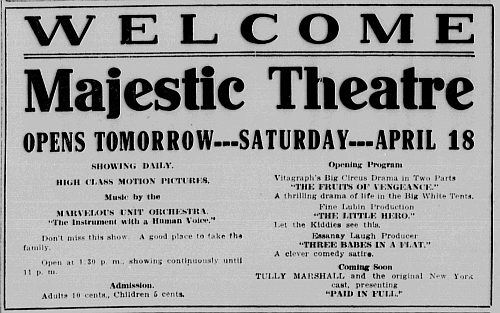
WELCOME
Majestic Theatre
OPENS TOMORROW---SATURDAY---APRIL 18SHOWING DAILY.
HIGH CLASS MOTION PICTURES.
Music by the
MARVELOUS UNIT ORCHESTRA.
"The Instrument with a Human Voice."Don't miss this show. A good place to take the family.
Open at 1:30 p.m., showing continuously until 11 p.m.
Admission.
Adults 10 cents, Children 5 cents.Opening Program
Vitagraph's Big Circus Drama in Two Parts
"THE FRUITS OF VENGEANCE."
A thrilling drama of life in the Big White Tents.Fine Lubin Production
"THE LITTLE HERO."
Let the Kiddies see this.Essanay Laugh Producer
"THREE BABES IN A FLAT."
A clever comedy satire.Coming Soon
TULLY MARSHALL and the original New York cast, presenting
"PAID IN FULL."
The accompanying news item:
Messrs. McCarty & Rothstein take great pleasure in announcing the opening tomorrow, Saturday afternoon and evening, of the New Majestic theater. During the past month the theatre has been in the hands of carpenters, painters, decorators, etc., and has been completely altered and improved, now presenting a most attractive appearance, one that will meet with the approval of all patrons. The house will be under the personal management of B. F. Rothstein, lately associated with Harry Davis, the well-known theatrical and motion picture magnate. It will be devoted exclusively to high class motion pictures and feature films in which appear the leading actors and actresses of the world, depicting the great theatrical successes. At an approximate expense of $10,000 the management has installed on of the famous Wurlitzer Unit orchestras, which combines piano with all orchestral acompaniements, such as horns, flute, violin, drums, cello, castanets, tambourine, whistles, bells, chimes, xylophones and traps. The management, at considerable additional expense secured a well-known artist of Dallas, Texas, to preside over this wonderful instrument. Recitals will be given afternoon and evening, thus affording the music-loving public a rare treat. It is the only instrument of its kind in the entire state of Oklahoma and weighs in the neighborhood of 6,000 pounds.
Reading through the puffery, it appears that this is a reopening after a remodel, rather than the opening of a new building.
What isn't clear is where this was. In 1910, the Bijou Theater sat at the corner of 4th and Main. In 1917 (according to Sanborn Maps), the new, new Majestic was built next door at 406 S. Main, and remained standing until demolished for the present occupant, a parking garage that takes up the north two-thirds of the block between Main, Boulder, 4th and 5th. Tulsa was small enough, and the business district was compact enough, that there was no need to clutter up a theater ad with an address.
First in a possible series. Newspapers and other publications from 1922 and earlier are in the public domain, and many of them are available online through the Library of Congress and Oklahoma Historical Society websites.
The April 17, 1914 edition of the Tulsa Daily World ran 12 pages. The front page headline was about the peaceful resolution of the Tampico Affair. Mexican President General Huerta offered to make amends for the arrest of American troops at Tampico. (The previous day's edition had a banner headline in red ink above the masthead announcing "War With Mexico Now Imminent / Bloodshed Likely at Track Today.")
Further down page 1, there was news of an arrest in the hatchet murder of Muskogee shopkeeper B. F. Richardson. The accused was Richardson's shop clerk, C. T. Hefler, who had been fired after an argument.
On the upper left of the women's page (p. 7) is the headline:
WORK FOR THE COMING SUMMER
IS BEING PLANNED RIGHT
NOW
EXPENSE IS NOT LARGE
Camp Away from the City's Heat
Would Do Much to Reduce Summer
Death Rate
The story was about a committee of Tulsa women pushing for the establishment of a "baby detention camp." No indication of where it would be located. The committee elected the following ladies as the board of directors.
Mesdames J. A. Hull, J. M. Gillette, S. E. Dunn, John Murray Ward, Frank Sowers, Edward R. Perry, Oscar R. Howard, Sim W. Parrish, J. E. Crosbie, Frank E. Shallenberger, O. L. Frost and Frank H. Greer.
A June 19, 1914, story reports that a home was purchased "opposite Orcutt park," accessible by the Oklahoma Union Traction streetcar line. The 1920 city directory shows the Tulsa Detention Home located at 1704 S. Trenton. Later, the 1939 Sanborn map shows a "County Children's Home" at 1710 S. Trenton at the corner with 17th Street. The homes currently on that corner are of much later construction.
An August 1, 1915, story distinguishes the new detention home ("near the old bungalow at Seventeenth and Spark Streets"), which seems to be an orphanage for children whose parents are deceased or unfit, from the baby camp. Both are run by the local Humane Society.
(In 1921, Wichita established a "Fresh Air Baby Camp" in its Riverside neighborhood. The building was later used as a Girl Scout hut, then sat empty for many years. At present, the building is being restored to its historical appearance. Fresh Air Baby Camp has a much nicer sound than Baby Detention Camp.)
IN OTHER NEWS:
The April 16 edition noted the paper's circulation on the previous day at 12,650.
Several ads in the paper boost the Tulsa Evening Sun, sister paper to the World, which began publication on December 1, 1913, and had a daily circulation of 4,000. "It has been proven that a morning paper with an evening edition is the solution of taking care of the 'overhead cost' in newspaper publishing."
Dr. Jeffrey Myers, a great-grandson of W. Tate Brady, posted a comment today on a BatesLine entry from July 2013 ("The Brady name game") regarding the renaming of Brady Street in Tulsa. Controversy over the early Tulsa civic leader's connection to racist organizations resulted in a bizarre City Council compromise that renamed Brady Street within the Inner Dispersal Loop to Matthew B. Brady Street, honoring the Civil War-era photographer who had no connection to Tulsa.
Below is Dr. Myers's comment, which is unedited, except for the addition of an authorship line to ensure it is properly attributed.
What´s in a Name: The Legacy of Tate Brady [by Dr. Jeffrey Myers]As one of the great-grandchildren of W. Tate Brady, I was deeply saddened to learn of his affiliation - direct or indirect - with racist organizations. Although he died long before I was born, we great-grandchildren often heard of his deep affection for "Tulsey Town" and his coining of the term "Tulsa Spirit".
Personally, I have never thought of "Brady" Street simply as a personal tribute to one of Tulsa´s founders, but rather a reminder of one of the most eventful and "spirited" chapters in the history of the city - with all of its triumphs and tragedies, virtues and vices, successes and failures. To preserve a name - including both the achievements and the shortcomings it represents - serves to convey historical identity.
In some ways, Tate Brady can be said to have been a child of his times. He was a member of the Sons of Confederate Veterans in a young city painfully divided along racial lines. He was a man filled with larger-than-life dreams, as well as inconsistencies. Having joined the Ku Klux Klan as a young man, he later renounced the group, going on to support an anti-Klan gubernatorial candidate for election.
If I am not mistaken, though, he is being judged for one substantiated act of cruelty which, despicable as it is, remains one single act. I am not aware of any evidence of his complicity in other crimes, nor is there convincing evidence linking him to an active role in the Tulsa Race Riot of 1921. Fortunately, times have changed; needless to say, actions must always be understood and judged in the context of those times. Historical revisionism is sometimes tempting, but often self-serving.
It has been said that Wyatt Tate Brady was known for hiring African Americans to work in his hotel and other businesses. Not long before she died at the age of 104, Mabel B. Little, a survivor of the Tulsa Race Riot who was once employed by Brady, recalls in her book, Fire on Mount Zion: My Life and History as a Black Woman in America (1990): "Another man, Mr. Tate Brady had good feelings for black people. He hired several black boys as porters. But he told them up front, "Listen, boys: I'm gonna train you so you can get your own businesses someday."
I´ve always liked the fact that this historical street north of Main only bore a surname - and not a first name, thus pointing beyond itself, not only to the larger Brady family - many of whom loved and gave generously of themselves and their gifts to Tulsa, but also to the wider family, named and unnamed, of pioneer-spirited Tulsans. The name Brady invokes that which is unique to Tulsa - not only at its best, but also that which needs to be transformed and redeemed, individually and together.
In a moment of larger vision, W. Tate Brady was once quoted as saying: "Indian and white man, Jew and Gentile, Catholic and Protestant, we worked together side by side, and shoulder to shoulder, and under these conditions, the 'Tulsa Spirit' was born, and has lived, and God grant that it never dies." Though framed in words from another era, this vision would seem to capture the magnanimous, unifying "spirit" of Tulsa - the direction surely intended by the street sign bearing the name "Brady".
I've been told that Leon Russell's voice is being used to greet travelers at the Tulsa International Airport, and that, in his greeting, he mentions seeing world-renowned violinist Jascha Heifetz at the Tulsa Municipal Theater, now known as the Brady Theater.
Heifetz appeared in Tulsa, at what was then known as the Convention Hall, many years earlier, on March 16, 1922, as part of a blockbuster concert series that included ballerina Anna Pavlova and pianist and composer Sergei Rachmaninoff.
The performers for the rest of the series are not well-remembered today, but they were famous at the time: Frances Alda (operatic soprano), Royal Dadmun (baritone), John McCormack (Irish tenor), Flonzaley Quartet (string quartet).
At the time, $10 got you season tickets for the best seat in the house. In inflation-adjusted terms, that's $15 per show. Individual tickets ran from $1 to $3, plus 10% war tax.
A newspaper advertisement for the series appeared on page 12 of the September 25, 1921, edition of the Tulsa Daily World:
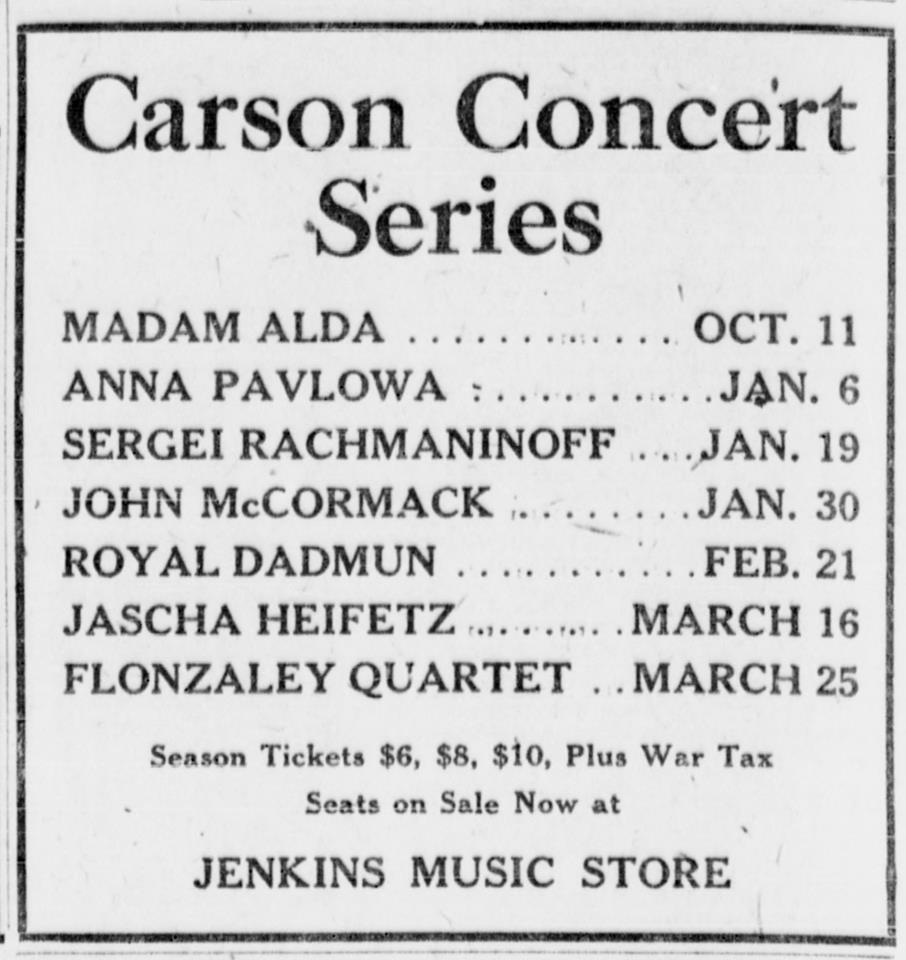
Don't know for sure, but I suspect that the Carson Concert Series was the forerunner for Carson Attractions, which handled tickets and booking for the Tulsa Assembly Center for many years.
1922 was not Heifetz's first visit to Tulsa. He also appeared at the Convention Hall on March 4, 1919. Ticket prices were 50 cents cheaper than they would be in 1922.
